Last updated: November 19, 2020
Article
Mary Colter and Her Buildings at Grand Canyon
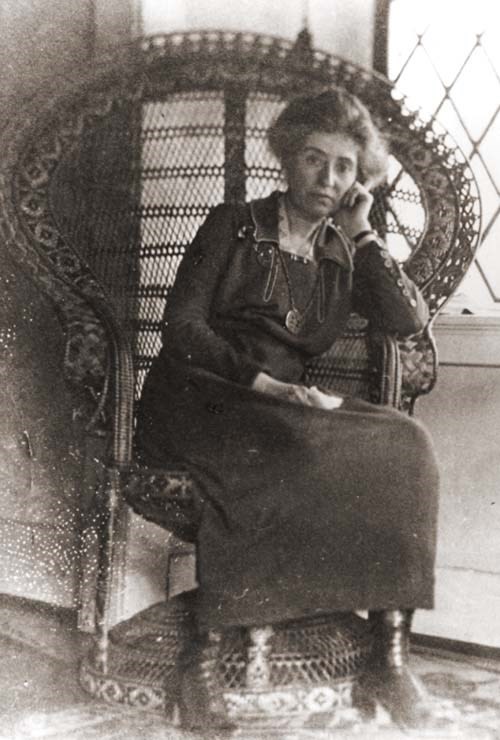
More importantly, her creative free-form buildings at Grand Canyon took direct inspiration from the landscape and served as part of the basis of the developing artistic aesthetic for appropriate development in areas that became national parks.
The buildings are also significant as part of the Atchison, Topeka & Santa Fe Railway and Fred Harvey Company development on the South Rim of Grand Canyon -- their most important destination resort.
The Desert View Watchtower possesses additional regional significance in its tower paintings of American Indian designs that were copied from prehistoric pictographs and petroglyphs.
Colter was a perfectionist, who spent a lifetime advocating and defending her aesthetic vision in a largely male-dominated field.
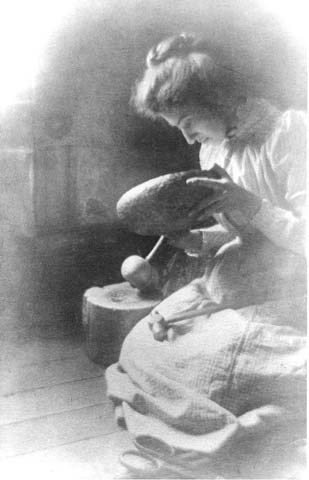
Mary Colter was born in Pittsburgh in 1869 and grew up in Texas, Colorado, and St. Paul, Minnesota. While attending the California School of Design in San Francisco she apprenticed in an architect's office and then went into teaching back in St. Paul.
Through informal contacts with the Fred Harvey Company, Colter eventually landed a job as interior designer of the Indian Building adjacent to the Santa Fe's new Alvarado Hotel in Albuquerque, along the main line. Although the Mission Revival style had been popular in California since the 1890s, the Alvarado Hotel and its adjacent Indian Building (both destroyed) were the first of their kind in New Mexico.
Her reputation swiftly grew, and her use of natural materials in forms that mimicked nature served as the basis for later work by architect Herbert Maier and others who designed what we now term "rustic" architecture. Colter was a perfectionist, who spent a lifetime advocating and defending her aesthetic vision in a largely male-dominated field. In 1948, at the age of 79, Colter officially retired from the Fred Harvey Company. She had been associated with the company for more than 46 years since her first job in 1902. On January 8, 1958, at the age of 88, Mary Elizabeth Jane Colter died.
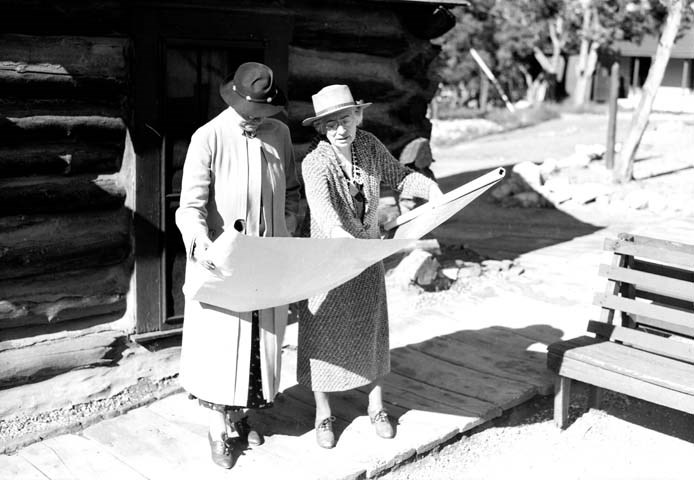
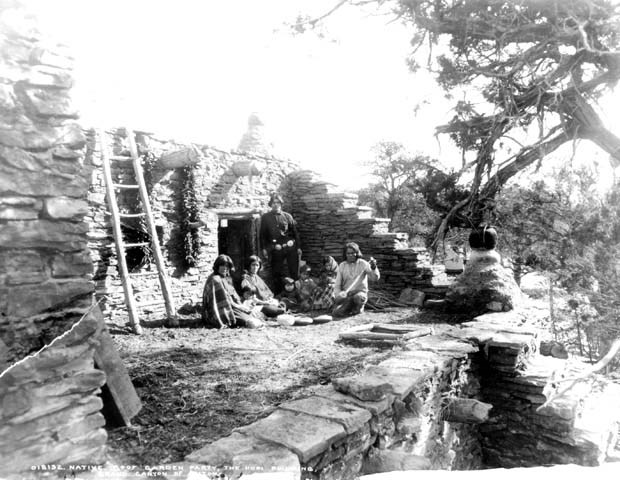
Hopi House
Hopi House (built in 1905) is a large, multi-story building of stone masonry, shaped and built like a Hopi pueblo. Originally designed to house the main salesrooms for Fred Harvey Indian Arts, Colter designed the building, set directly across from El Tovar Hotel, to resemble a Hopi dwelling, after those at Orainbi, Arizona.
Initially, Hopi House was an actual dwelling: some of the Hopis who worked in the building lived on the upper floors. The Hopi House is rectangular in plan, and the multiple roofs are stepped at various levels giving the building the impression of pueblo architecture. The sandstone walls are reddish in color, and tiny windows, like those of true Hopi structures, allow only the smallest amount of light into the building. On the interior, the floor finish on the first story is concrete.
Most of the rooms have the typical ceiling of the Hopi style: saplings, grasses, and twigs with a mud coating on top, resting on peeled log beams. Corner fireplaces, small niches in the walls, and a mud-plaster wall finish, typical of Hopi interiors, are also character defining features.
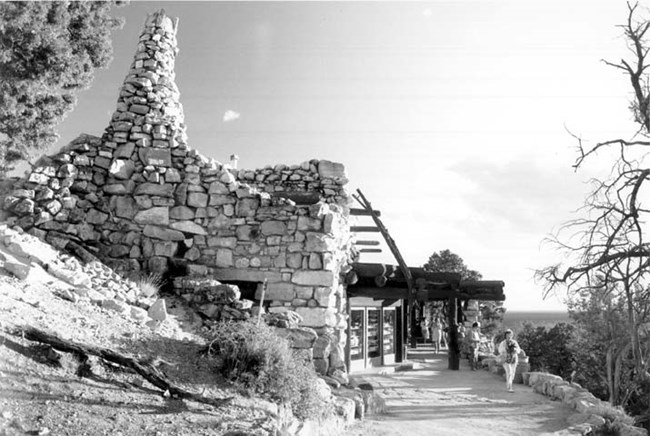
Hermit's Rest
Hermit's Rest (built in 1914), several miles to the west of Hopi House, is an entirely different type of structure. The building, originally constructed as a rest stop for the short stage line that ran from El Tovar to this location, is a stone building placed several feet back from the rim edge, and is tucked into a small man-made earthen mound, built around and atop the building to blend it in with its setting.
Hermit's Rest was designed to resemble a dwelling constructed by an untrained mountain man using the natural timber and boulders of the area. From the entrance path a haphazard looking structure of stone and wood greets the visitor, and the approach to Hermit's Rest is marked by a small stone arch set in a stone wall along the original pathway from the parking area to the building. The exposed portions of the building that are not banked into the earth are of rubble masonry bonded with cement mortar, structural logs, and a few expanses of glass. The chimneys are gently battered rubble masonry.
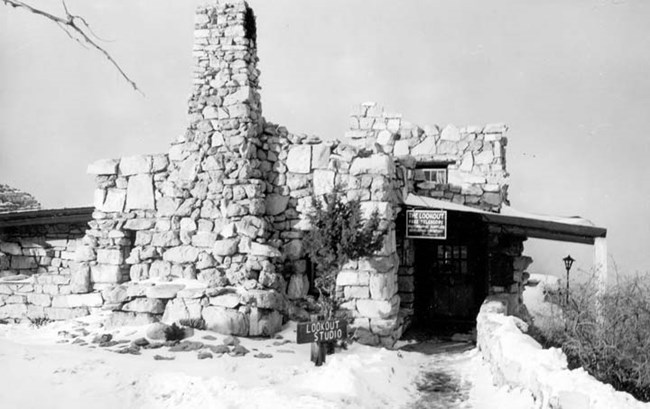
Lookout Studio
Lookout Studio (built in 1914) was designed as a location where visitors could photograph the Grand Canyon from its precipitous edge and use the telescopes to observe the natural beauty the canyon offered. Built on a precipice west of El Tovar, "the Lookout" offered a neat, comfortable rustic studio of stone and log timbers.
Colter designed the exterior stonework to convey an indigenous Native American structure, similar to the ruins of ancient Native American dwellings found in the region. Here, she allowed the edge of the canyon and the natural rock outcroppings give form to her multi-level structure that grew out of the edge of the rim.
Inspired by the natural forms of the landscape around the site, the parapet rooflines and stone chimneys mimicked the irregular shapes of surrounding bedrock. The interior of the building is divided into several levels, with structural logwork exposed in posts, beams, and ceiling joists. The floor is scored concrete and the interior walls are exposed stone. Because of all of the viewing windows around the walls of the structure, the interior is considerably lighter than most of Colter's other buildings.
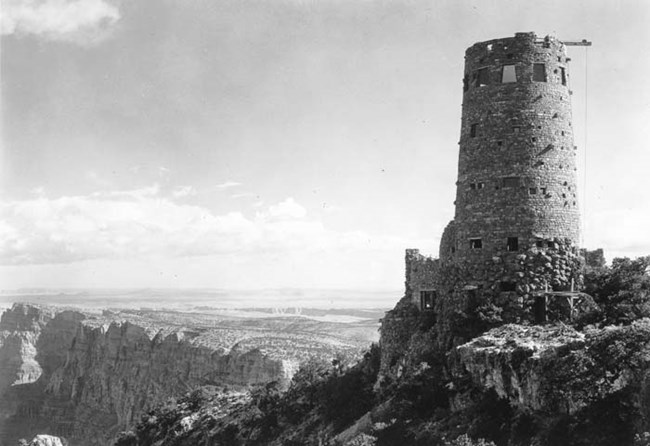
Desert View Watchtower
The Desert View Watchtower (built in 1932), one of the last of this series of Colter buildings, stands at the eastern end of the south rim of Grand Canyon. From a distance the building's silhouette looks like the Ancestral Puebloan watchtower it was meant to mimic. In plan the structure is composed of one enormous circle at the north, a small circle at the south, and gently arched forms connecting the two.
As Virginia L. Grattan wrote in Mary Colter Builder Upon the Red Earth, "[Desert View Watchtower] was not a copy, but what Colter called a 're-creation' of an Indian watchtower." Standing at 70 feet, with a 30-foot base, the tower was unique in having a concrete foundation and a steel framework well hidden in the stones of the tower.
The ground level of the tower was a large, round observation room with a spectacular view of Grand Canyon. Upstairs the Hopi Room presents paintings by Hopi artist Fred Kabotie, who took the room's theme from the Hopi Snake Dance. An outdoor observation deck is directly above the observation room.
As a group, these buildings were designated a National Historic Landmark District on May 28, 1987. Read the full nomination.
Tags
- grand canyon national park
- mary colter
- grand canyon
- architechure
- grand canyon centennial
- gc historic accounts
- women's history
- engaging with the environment
- arizona
- national historic landmark district
- designated 05/28/1987
- reference number 87001436
- women of the nps
- historic women of the nps
- nps history
